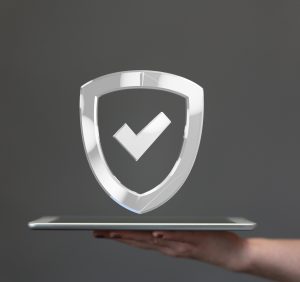 Browse. Click. Pay. Online shopping is just that easy.
Browse. Click. Pay. Online shopping is just that easy.
And while there’s a lot to be said for shopping locally and supporting small businesses, there’s no denying that online shopping is super convenient.
After all, where else can you find almost anything you want, place an order in minutes, and have your heart’s desire arrive on your doorstep in a matter of days or hours?
Seems like the perfect solution to all your shopping needs, right?
Not exactly.
Unfortunately, despite all its benefits, online shopping can have a dark side too.
Earlier this year, the Federal Trade Commission (FTC) released some sobering data. They found that in 2021, consumers reported losing more than $5.8 billion to fraud across a variety of categories including imposter scams and online shopping. This figure represents an increase of more than 70 percent over the losses in 2020. Yikes!
To help keep you safe, we’ve put together a list of six things you can do to help ensure that your online shopping experiences are good ones.
1. Stick with sites you know.
Whenever possible, buy only from sites you already know and trust. Although, it can be tempting to click on that flashy ad, you’re almost always better off only engaging with familiar brands who have a long-standing history of delivering quality products and service. When in doubt about the validity of a company or its website, skip the web entirely, and use a brand’s app to access its products instead. Nearly every big brand and retailer has its own app these days, and often you can get extra benefits and rewards by opting to use it.
 2. Make sure the site you’re on is legit.
2. Make sure the site you’re on is legit.
Whether you think you’re on the site of a brand you already know and love, or have decided to throw caution to the wind and try out a new online store, there are a number of red flags to watch for. It’s definitely worth your time to do a little more digging around before you hand over your credit card or PayPal information.
Be on the lookout for one or more of these potential signs of online trouble:
-
- Http instead of Https: The “s” at the end of https stands for “secure,” and when you see it in a website’s URL, you know that the site you’re visiting has SSL (secure sockets layer) encryption, which is critical for protecting your personal information—including credit card information—from hackers and other thieves. If there’s no “s,” you might want to rethink your next step.
-
- Suspect link sources: It’s always best to type a site’s URL in directly or link from a search results page. It’s much riskier to click a link in an email or online ad. Scammers often use illegitimate links in official-looking ads, texts, and emails to get consumers to a site that looks like the real thing, but is actually a “spoof” of the real site.URL shorteners (like bit.ly) can also be problematic, so be extra careful. If you do click a shortened link or one from a potentially suspect source, make sure to double check that the URL you land on is, in fact, the site you’re trying to reach. Also, watch out for subtle misspellings or a site using a different top-level domain (e.g., like .net instead of .com).
-
- Sites that ask for too much information: Beware of shopping sites that ask you for more than your billing and shipping information. If, for instance, you’re asked to provide a social security number or banking information, you can assume that you are in danger of being scammed.
-
- No customer service: Legitimate companies typically have robust customer service departments that you can access via email, phone, and chat. Disreputable (or non-existent) companies can’t offer this kind of support. Check to see if there’s a “Contact Us” and/or “Customer Service” page.
-
- Deals that are too good to be true: We’ve all been tempted by that really great deal from a company we’ve never heard of. But, as the saying goes, “You get what you pay for,” and sometimes you pay for something and get nothing at all! If the offer seems like a once-in-a-lifetime opportunity, do a little more research. Check out online resources like the Better Business Bureau, scam sites, and general reviews.
3. Create strong passwords.
You’ve been meaning to get better about your password management for years, but it always seems to fall to the bottom of the to-do list. We understand, but creating and updating passwords responsibly is a relatively easy thing to do now that can save you a lot of grief later.
Here are a few tips from our article on cybersecurity:
- Create unique passwords for each site and app.
- Avoid including real words in your passwords. Hackers have software that can crack those easily.
- Don’t use personal information–like your birthday or your mother’s maiden name–in your passwords.
- Make sure each password includes a variety of character types: upper and lowercase letters, numbers, and special characters.
- When the option is available, take advantage of auto-generated passwords such as the ones suggested by Google Chrome.
- Never keep your passwords in plain text (meaning unencrypted), whether on your computer or your phone.
- Consider using a password manager. Apps like LastPass, 1Password, and Bitwarden keep your passwords secure while also helping you manage them more easily.
4. Pay attention to your credit card and other account statements.
Make it a habit to check your bank, credit card, and payment app (PayPal, Venmo, etc.) accounts on a regular basis. Monitoring your charges frequently can help you quickly uncover any suspicious activity. And, being able to respond fast can make a big difference in preventing a possible bad outcome.
5. Use a credit card instead of a debit card.
Because debit cards are connected directly to your bank account, they are a particularly attractive target for online scammers. If your debit card is compromised, a digital thief can potentially drain your account before you even know what happened. To avoid this very unpleasant scenario, use a credit card for online purchases. This way, even if your card is hacked, the hacker won’t be able to withdraw any funds from your actual account.
6. Protect Your Tech. 
While it’s important to make smart decisions about how and where you shop online, there are also some basic hardware and software security measures you should take to protect your data and personal information.
Four critical tasks that help you protect your tech include:
- Updating your software;
- Avoiding public WiFi;
- Using a VPN; and
- Installing antivirus software.
If you do get scammed or hacked, don’t be afraid to speak up.
There’s nothing embarrassing about being taken in by an online shopping scam. Whether you fell for a spoofed site, clicked an illegitimate email link, or failed to protect your password from hackers, don’t beat yourself up about it. We all make mistakes, and today’s online thieves are a sophisticated and persistent bunch.
Instead of feeling guilty or ashamed, take action by reporting the crime to the FTC, your state’s attorney general, or the FBI. These agencies want to help. And if your tip helps them catch the bad guys, you may be saving some other shoppers a lot of headaches.
We hope that knowing how to protect yourself and your assets while shopping online will make the delights of shopping from your couch while in your pajamas even more enjoyable. Happy shopping, and stay safe out there!
Related Posts:
Protect Yourself from Cybercrime and Identity Theft
 Connecticut Estate Planning Attorneys Blog
Connecticut Estate Planning Attorneys Blog


